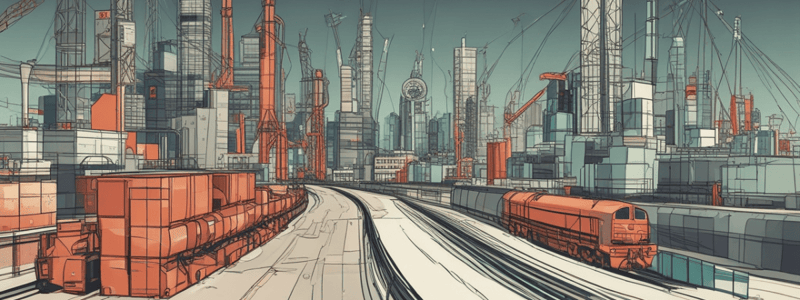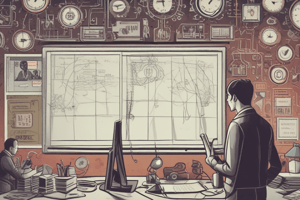Podcast
Questions and Answers
Which type of manager, according to McGregor, believes that subordinates are active and responsible?
Which type of manager, according to McGregor, believes that subordinates are active and responsible?
- Theory X Manager
- Theory Y Manager (correct)
- Classical Manager
- Human Relations Manager
What is the main advantage of large-scale production in an organization?
What is the main advantage of large-scale production in an organization?
- Better decision-making
- Increased job satisfaction
- Economies of Scale (correct)
- Improved communication
What is the main goal of organizational redesign according to Organizational Theory?
What is the main goal of organizational redesign according to Organizational Theory?
- To improve customer satisfaction
- To maximize profits
- To maintain and increase effectiveness (correct)
- To reduce employee turnover
What is the main idea behind Argyris' Growth Perspective?
What is the main idea behind Argyris' Growth Perspective?
What is the primary purpose of organizational change?
What is the primary purpose of organizational change?
What is the type of arbitration where two sides have agreed to abide by the arbitrator's decision?
What is the type of arbitration where two sides have agreed to abide by the arbitrator's decision?
What is the force that compels organizations to change how and where they produce goods and services?
What is the force that compels organizations to change how and where they produce goods and services?
What is the result of power conflict during organizational change?
What is the result of power conflict during organizational change?
What is the technique developed by W. Edwards Deming to increase organizational effectiveness?
What is the technique developed by W. Edwards Deming to increase organizational effectiveness?
What is the primary focus of Organizational Theory?
What is the primary focus of Organizational Theory?
What is the concept of Span of Control related to?
What is the concept of Span of Control related to?
What is a key assumption of early organizational theories?
What is a key assumption of early organizational theories?
Which of the following is NOT a component of an organization's system?
Which of the following is NOT a component of an organization's system?
What is the primary concern of Systems Theory in an organizational context?
What is the primary concern of Systems Theory in an organizational context?
What is the purpose of organizational change?
What is the purpose of organizational change?
What type of forces compel organizations to change how and where they produce goods and services?
What type of forces compel organizations to change how and where they produce goods and services?
What is the goal of socializing employees into the organizational culture?
What is the goal of socializing employees into the organizational culture?
What is the result of differences in functional orientation during organizational change?
What is the result of differences in functional orientation during organizational change?
What is the primary focus of Total Quality Management (TQM)?
What is the primary focus of Total Quality Management (TQM)?
What is the purpose of arbitration in organizational change?
What is the purpose of arbitration in organizational change?
What is the result of power conflict during organizational change?
What is the result of power conflict during organizational change?
What is the primary goal of new investment in training and development activities?
What is the primary goal of new investment in training and development activities?
What is the purpose of changing organizational norms and values?
What is the purpose of changing organizational norms and values?
What is the result of demographic and social forces on organizations?
What is the result of demographic and social forces on organizations?
Flashcards are hidden until you start studying
Study Notes
Organizational Theory
- Organizational theory is the study of how organizations function and how they affect and are affected by the environment in which they operate.
- It is a set of propositions that explains or predicts how groups and individuals behave in varying organizational structures and circumstances.
Classical Theory
- Bureaucracy is a structure proposed by Max Weber to be the ideal form of organization, including a formal hierarchy, division of labor, and a clear set of operating procedures.
- Division of labor is the division of tasks performed in an organization into specialized jobs and departmental functions.
- Delegation of authority is the information about the decision-making process and the distribution of power within an organization.
- Span of control is the number of positions or people who report to a single individual.
Human Relations Theory
- Human Relations Theory adds a personal or human element to the study of organizations, considering the interrelationship between an organization's requirements and characteristics of its members.
- McGregor's Theory X and Theory Y explain the beliefs that managers hold about their subordinates, influencing their behavior towards those subordinates.
- Theory X Managers believe that subordinate behavior had to be controlled to meet organizational ends, while Theory Y Managers believe that subordinates are active and responsible and would be more motivated to meet organizational goals without constraining controls.
Organization
- An organization is a tool people use to coordinate their actions to obtain something they desire or value, to achieve a goal.
- Organization's inputs, conversion process, outputs, and environment are key components of an organization.
Organizational Change
- Organizational change is the process by which organizations move from their current or present state to some desired future state to increase their effectiveness.
- Targets of change include human resources, organizational norms, and values.
Resistance to Change
- Resistance to change can occur at the organizational level, including power conflict, differences in functional orientation, and fear of the unknown.
Change Management Strategies
- Total Quality Management (TQM) is a technique developed by W. Edwards Deming to improve organizational effectiveness.
- Empowerment and participation are strategies used to increase employee motivation and involvement in organizational change.
- Building alliances and networks can be used to create new relationships or technical relationships to increase organizational effectiveness.
Organizational Theory
- Organizational theory is the study of how organizations function and how they affect and are affected by the environment in which they operate.
- It is a set of propositions that explains or predicts how groups and individuals behave in varying organizational structures and circumstances.
Classical Theory
- Bureaucracy is a structure proposed by Max Weber to be the ideal form of organization, including a formal hierarchy, division of labor, and a clear set of operating procedures.
- Division of labor is the division of tasks performed in an organization into specialized jobs and departmental functions.
- Delegation of authority is the information about the decision-making process and the distribution of power within an organization.
- Span of control is the number of positions or people who report to a single individual.
Human Relations Theory
- Human Relations Theory adds a personal or human element to the study of organizations, considering the interrelationship between an organization's requirements and characteristics of its members.
- McGregor's Theory X and Theory Y explain the beliefs that managers hold about their subordinates, influencing their behavior towards those subordinates.
- Theory X Managers believe that subordinate behavior had to be controlled to meet organizational ends, while Theory Y Managers believe that subordinates are active and responsible and would be more motivated to meet organizational goals without constraining controls.
Organization
- An organization is a tool people use to coordinate their actions to obtain something they desire or value, to achieve a goal.
- Organization's inputs, conversion process, outputs, and environment are key components of an organization.
Organizational Change
- Organizational change is the process by which organizations move from their current or present state to some desired future state to increase their effectiveness.
- Targets of change include human resources, organizational norms, and values.
Resistance to Change
- Resistance to change can occur at the organizational level, including power conflict, differences in functional orientation, and fear of the unknown.
Change Management Strategies
- Total Quality Management (TQM) is a technique developed by W. Edwards Deming to improve organizational effectiveness.
- Empowerment and participation are strategies used to increase employee motivation and involvement in organizational change.
- Building alliances and networks can be used to create new relationships or technical relationships to increase organizational effectiveness.
Studying That Suits You
Use AI to generate personalized quizzes and flashcards to suit your learning preferences.




